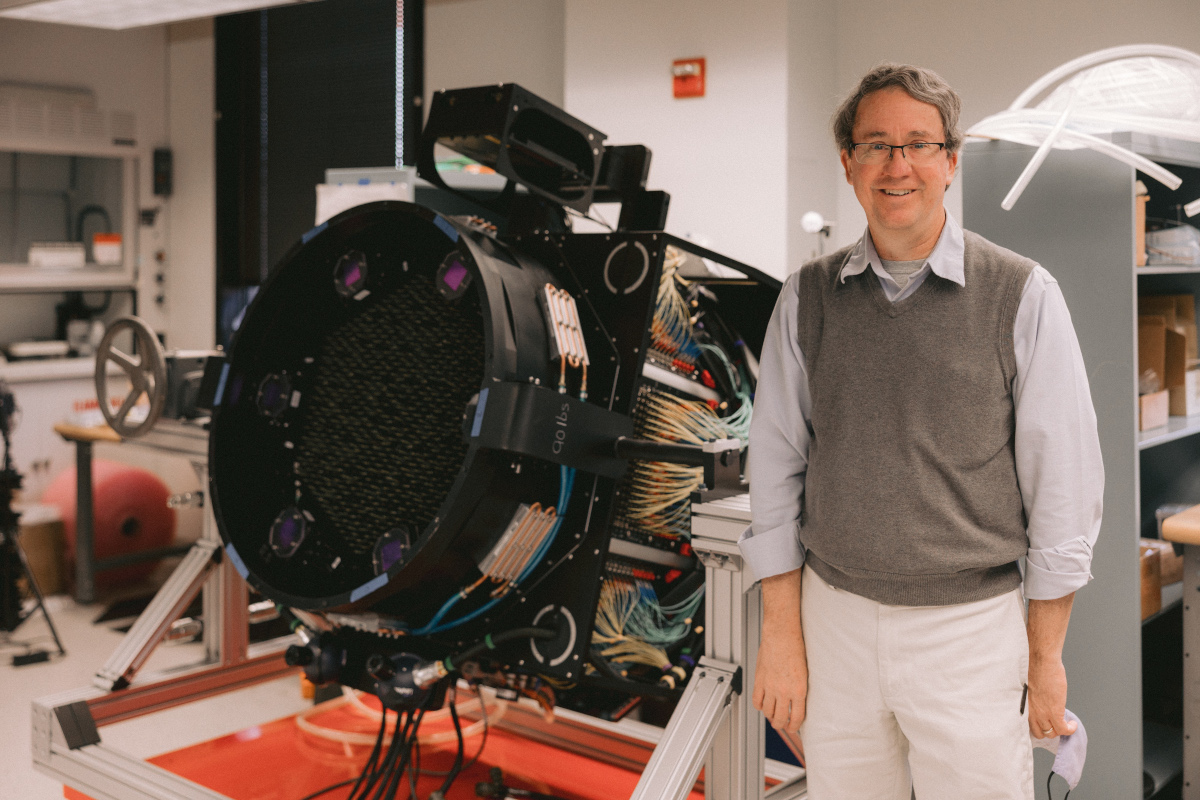 Originally from the Indian Wells Valley in California's Northern Mojave Desert, I attended Sherman E. Burroughs High
School (Class of 1979) in Ridgecrest, California,
otherwise known as the "Gateway to
Death Valley", and home of the China Lake Naval Air
Weapons Station (it was just NOTS, then NWC, when I was there).
While at China Lake I was a member of the China Lake Astronomical
Society, the folks who helped give me a start in Astronomy, and
Boy Scout Troop 35, to whom I owe my abiding love of the outdoors. In
1979 I left the desert to attend Caltech, where I received my BS in
Physics in 1983. At Caltech I was a member of Dabney
House, and a sometime member of the infamous InfraRed
Army. After graduation I headed north up the coast
to UC Santa Cruz,
where I received my PhD in Astronomy & Astrophysics in
1988. After a year at
the University of Texas at
Austin as a McDonald Fellow, I arrived at The Ohio State University as a postdoc in 1989,
joining the faculty of the Astronomy
Department in 1992 as an Assistant Professor. I have been a Full
Professor of Astronomy at OSU since 2003. In 2021 I was named a College of Arts and Sciences
Distinguished Professor of Astronomy.
Originally from the Indian Wells Valley in California's Northern Mojave Desert, I attended Sherman E. Burroughs High
School (Class of 1979) in Ridgecrest, California,
otherwise known as the "Gateway to
Death Valley", and home of the China Lake Naval Air
Weapons Station (it was just NOTS, then NWC, when I was there).
While at China Lake I was a member of the China Lake Astronomical
Society, the folks who helped give me a start in Astronomy, and
Boy Scout Troop 35, to whom I owe my abiding love of the outdoors. In
1979 I left the desert to attend Caltech, where I received my BS in
Physics in 1983. At Caltech I was a member of Dabney
House, and a sometime member of the infamous InfraRed
Army. After graduation I headed north up the coast
to UC Santa Cruz,
where I received my PhD in Astronomy & Astrophysics in
1988. After a year at
the University of Texas at
Austin as a McDonald Fellow, I arrived at The Ohio State University as a postdoc in 1989,
joining the faculty of the Astronomy
Department in 1992 as an Assistant Professor. I have been a Full
Professor of Astronomy at OSU since 2003. In 2021 I was named a College of Arts and Sciences
Distinguished Professor of Astronomy.
My primary research is concerned with the astrophysics of gaseous nebulae and active galactic nuclei as revealed through imaging and spectrophotometry at optical, UV, and infrared wavelengths with ground-based and space-based telescopes. I've followed three lines of inquiry. The first seeks to refine measurements of the masses of supermassive black holes in nearby active galaxies with the goal of calibrating the key scaling relations that will allow us to extend local methods out to cosmological distances. The second used the Hubble and Chandra space telescopes to study how local active nuclei are fed by gas from their host galaxies, and how that activity in turn feeds back upon their hosts. The third is to use precision spectrophotometry to measure direct and empirical elemental gas-phase abundances in star formation regions to trace the chemical evolution history of galaxies from the Big Bang to the present.
At home in the Milky Way, I have joined in the search for planets around other stars. I am part of the MicroFUN collaboration based at OSU that has organized a worldwide network of amateur and professional telescopes to make coordinated observations to search for extrasolar planetary systems using gravitational microlensing. I have also been engaged searches for and detailed follow-up studies of transiting exoplanets, through the KELT North, KELT South, and DEMONEXT projects, as well as exploring new techniques using adaptive optics.
Research requires the best data, and to collect that data I have devoted much of my career to the the design and construction of advanced astronomical instruments, including development of software for image processing, spectral analysis, and instrument control & data acquisition. Instruments I have helped develop are in regular use at the MDM and LBT observatories in Arizona, and for SDSS-V at Apache Point Observatory in New Mexico and Las Campanas Observatory in Chile. My biggest instrumentation projects to date are the two Multi-Object Double Spectrographs (MODS) on the Large Binocular Telescope on Mt. Graham in Arizona and the robotic Focal Plane Systems for SDSS-V.
CV and Bibliography
- Curriculum Vitae (PDF/A)
- Bibliography (PDF/A)
Teaching
In-Person Courses
- Astronomy 2140: Planets and the Solar System - Sp2025
- Astronomy 1101: From Planets to the Cosmos - Au2024
- Astronomy 2292: Stellar, Galactic, & Extragalactic Astrophysics - Sp2024
- Astronomy 2291: Basic Astrophysics & Planetary Astronomy - Au2023 and Au2025
- Astronomy 1101: From Planets to the Cosmos - Au2024
Online Courses
- From Planets to the Cosmos (on ScarletCanvas)
- Introduction to Solar System Astronomy (on Apple Podcasts)
- Stars, Galaxies, & the Universe (on Apple Podcasts)
- Life in the Universe (on Apple Podcasts)
- Introduction to Solar System Astronomy (on Apple Podcasts)
Resources
- Introductory Teaching Resources
- Course Podcasts (2006-2009): [Ast 161|Ast 162|Ast 141]
Ohio State Astrophysics Series
About
- Editor in Chief: Barbara Ryden
- Technical Editor: Richard Pogge
Books
- Volume 1: Interstellar and Intergalactic Medium,
Barbara Ryden & Richard Pogge, May 2021
- Volume 2: Stellar Structure and Evolution, Marc Pinsonneault & Barbara Ryden, June 2023
- Volume 3: Celestial and Stellar Dynamics, Barbara Ryden, April 2025
- Volume 4: Astrophysical Gas Dynamics, Barbara Ryden, 2026
- Volume 2: Stellar Structure and Evolution, Marc Pinsonneault & Barbara Ryden, June 2023